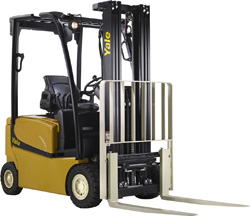
Wacker Neuson has expanded its compact equipment line with a new all-wheel-steer wheel loader that delivers excellent maneuverability and stability. The 1150 wheel loader features a 4-wheel steer system and rigid frame design and is the largest of the Wacker Neuson wheel loader line.
“The new 1150 is powered by a turbo-charged Deutz engine (77.8 hp) and has an exceptional power to weight ratio making this unit very fuel efficient and economical to run,” says Jay Baudhuin, compact equipment product manager for Wacker Neuson Corporation.
The 5.9-metric-ton model offers 9,127 pounds of tipping capacity even at full turn with a 1.5-cubic-yard standard bucket. “This machine offers superior break-out force,” adds Baudhuin. “It has the power and capacity to do the heavy lifting without sacrificing maneuverability and stability.”
The 1150 is user-friendly with a spacious operator station that allows for excellent 360-degree visibility and ergonomics. A single joystick operation allows for precise work with minimum effort and reduced fatigue. The hydraulically operated quick-hitch allows for efficient changing from one attachment to another without leaving the operator’s station.
Wacker Neuson’s new 1150 complements the already introduced 280 and 850 all wheel steer models as well as the four articulated models. “Now with seven models to choose from with a variety of power and performance ratings, Wacker Neuson wheel loaders are an economical alternative to skid steer loaders as they can perform the same tasks, faster and more smoothly on the job,” says Baudhuin.
Source : heg.baumpub





